Input interpretation

HNO_3 (nitric acid) + NaOH (sodium hydroxide) ⟶ H_2O (water) + NaNO_3 (sodium nitrate)
Balanced equation
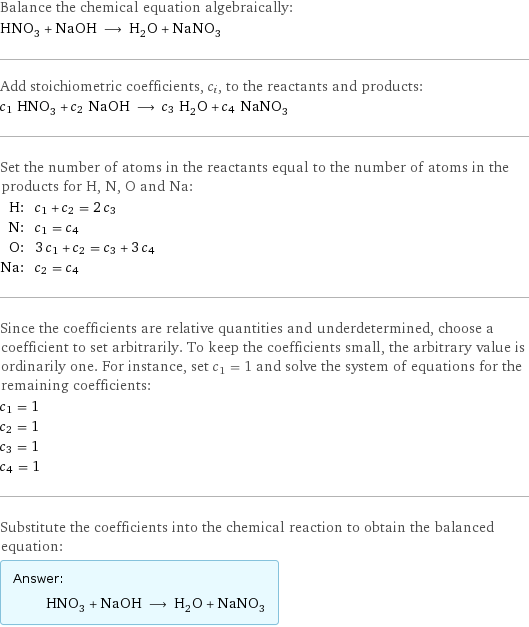
Balance the chemical equation algebraically: HNO_3 + NaOH ⟶ H_2O + NaNO_3 Add stoichiometric coefficients, c_i, to the reactants and products: c_1 HNO_3 + c_2 NaOH ⟶ c_3 H_2O + c_4 NaNO_3 Set the number of atoms in the reactants equal to the number of atoms in the products for H, N, O and Na: H: | c_1 + c_2 = 2 c_3 N: | c_1 = c_4 O: | 3 c_1 + c_2 = c_3 + 3 c_4 Na: | c_2 = c_4 Since the coefficients are relative quantities and underdetermined, choose a coefficient to set arbitrarily. To keep the coefficients small, the arbitrary value is ordinarily one. For instance, set c_1 = 1 and solve the system of equations for the remaining coefficients: c_1 = 1 c_2 = 1 c_3 = 1 c_4 = 1 Substitute the coefficients into the chemical reaction to obtain the balanced equation: Answer: | | HNO_3 + NaOH ⟶ H_2O + NaNO_3
Structures
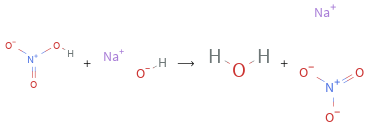
+ ⟶ +
Names

nitric acid + sodium hydroxide ⟶ water + sodium nitrate
Reaction thermodynamics
Gibbs free energy
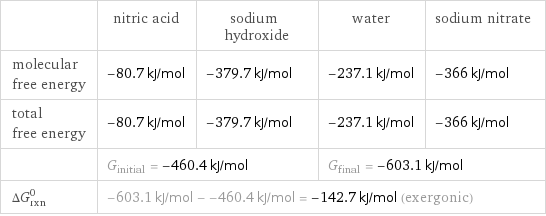
| nitric acid | sodium hydroxide | water | sodium nitrate molecular free energy | -80.7 kJ/mol | -379.7 kJ/mol | -237.1 kJ/mol | -366 kJ/mol total free energy | -80.7 kJ/mol | -379.7 kJ/mol | -237.1 kJ/mol | -366 kJ/mol | G_initial = -460.4 kJ/mol | | G_final = -603.1 kJ/mol | ΔG_rxn^0 | -603.1 kJ/mol - -460.4 kJ/mol = -142.7 kJ/mol (exergonic) | | |
Entropy
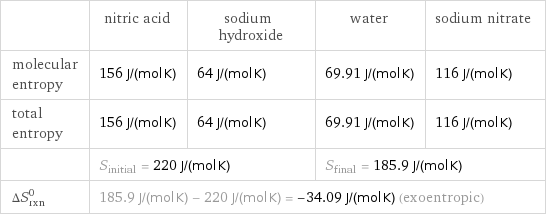
| nitric acid | sodium hydroxide | water | sodium nitrate molecular entropy | 156 J/(mol K) | 64 J/(mol K) | 69.91 J/(mol K) | 116 J/(mol K) total entropy | 156 J/(mol K) | 64 J/(mol K) | 69.91 J/(mol K) | 116 J/(mol K) | S_initial = 220 J/(mol K) | | S_final = 185.9 J/(mol K) | ΔS_rxn^0 | 185.9 J/(mol K) - 220 J/(mol K) = -34.09 J/(mol K) (exoentropic) | | |
Equilibrium constant
![Construct the equilibrium constant, K, expression for: HNO_3 + NaOH ⟶ H_2O + NaNO_3 Plan: • Balance the chemical equation. • Determine the stoichiometric numbers. • Assemble the activity expression for each chemical species. • Use the activity expressions to build the equilibrium constant expression. Write the balanced chemical equation: HNO_3 + NaOH ⟶ H_2O + NaNO_3 Assign stoichiometric numbers, ν_i, using the stoichiometric coefficients, c_i, from the balanced chemical equation in the following manner: ν_i = -c_i for reactants and ν_i = c_i for products: chemical species | c_i | ν_i HNO_3 | 1 | -1 NaOH | 1 | -1 H_2O | 1 | 1 NaNO_3 | 1 | 1 Assemble the activity expressions accounting for the state of matter and ν_i: chemical species | c_i | ν_i | activity expression HNO_3 | 1 | -1 | ([HNO3])^(-1) NaOH | 1 | -1 | ([NaOH])^(-1) H_2O | 1 | 1 | [H2O] NaNO_3 | 1 | 1 | [NaNO3] The equilibrium constant symbol in the concentration basis is: K_c Mulitply the activity expressions to arrive at the K_c expression: Answer: | | K_c = ([HNO3])^(-1) ([NaOH])^(-1) [H2O] [NaNO3] = ([H2O] [NaNO3])/([HNO3] [NaOH])](../image_source/aa168068d72e9a97b4671ed139f797ab.png)
Construct the equilibrium constant, K, expression for: HNO_3 + NaOH ⟶ H_2O + NaNO_3 Plan: • Balance the chemical equation. • Determine the stoichiometric numbers. • Assemble the activity expression for each chemical species. • Use the activity expressions to build the equilibrium constant expression. Write the balanced chemical equation: HNO_3 + NaOH ⟶ H_2O + NaNO_3 Assign stoichiometric numbers, ν_i, using the stoichiometric coefficients, c_i, from the balanced chemical equation in the following manner: ν_i = -c_i for reactants and ν_i = c_i for products: chemical species | c_i | ν_i HNO_3 | 1 | -1 NaOH | 1 | -1 H_2O | 1 | 1 NaNO_3 | 1 | 1 Assemble the activity expressions accounting for the state of matter and ν_i: chemical species | c_i | ν_i | activity expression HNO_3 | 1 | -1 | ([HNO3])^(-1) NaOH | 1 | -1 | ([NaOH])^(-1) H_2O | 1 | 1 | [H2O] NaNO_3 | 1 | 1 | [NaNO3] The equilibrium constant symbol in the concentration basis is: K_c Mulitply the activity expressions to arrive at the K_c expression: Answer: | | K_c = ([HNO3])^(-1) ([NaOH])^(-1) [H2O] [NaNO3] = ([H2O] [NaNO3])/([HNO3] [NaOH])
Rate of reaction
![Construct the rate of reaction expression for: HNO_3 + NaOH ⟶ H_2O + NaNO_3 Plan: • Balance the chemical equation. • Determine the stoichiometric numbers. • Assemble the rate term for each chemical species. • Write the rate of reaction expression. Write the balanced chemical equation: HNO_3 + NaOH ⟶ H_2O + NaNO_3 Assign stoichiometric numbers, ν_i, using the stoichiometric coefficients, c_i, from the balanced chemical equation in the following manner: ν_i = -c_i for reactants and ν_i = c_i for products: chemical species | c_i | ν_i HNO_3 | 1 | -1 NaOH | 1 | -1 H_2O | 1 | 1 NaNO_3 | 1 | 1 The rate term for each chemical species, B_i, is 1/ν_i(Δ[B_i])/(Δt) where [B_i] is the amount concentration and t is time: chemical species | c_i | ν_i | rate term HNO_3 | 1 | -1 | -(Δ[HNO3])/(Δt) NaOH | 1 | -1 | -(Δ[NaOH])/(Δt) H_2O | 1 | 1 | (Δ[H2O])/(Δt) NaNO_3 | 1 | 1 | (Δ[NaNO3])/(Δt) (for infinitesimal rate of change, replace Δ with d) Set the rate terms equal to each other to arrive at the rate expression: Answer: | | rate = -(Δ[HNO3])/(Δt) = -(Δ[NaOH])/(Δt) = (Δ[H2O])/(Δt) = (Δ[NaNO3])/(Δt) (assuming constant volume and no accumulation of intermediates or side products)](../image_source/c32dcbf8688180ee975e28a702d1be7f.png)
Construct the rate of reaction expression for: HNO_3 + NaOH ⟶ H_2O + NaNO_3 Plan: • Balance the chemical equation. • Determine the stoichiometric numbers. • Assemble the rate term for each chemical species. • Write the rate of reaction expression. Write the balanced chemical equation: HNO_3 + NaOH ⟶ H_2O + NaNO_3 Assign stoichiometric numbers, ν_i, using the stoichiometric coefficients, c_i, from the balanced chemical equation in the following manner: ν_i = -c_i for reactants and ν_i = c_i for products: chemical species | c_i | ν_i HNO_3 | 1 | -1 NaOH | 1 | -1 H_2O | 1 | 1 NaNO_3 | 1 | 1 The rate term for each chemical species, B_i, is 1/ν_i(Δ[B_i])/(Δt) where [B_i] is the amount concentration and t is time: chemical species | c_i | ν_i | rate term HNO_3 | 1 | -1 | -(Δ[HNO3])/(Δt) NaOH | 1 | -1 | -(Δ[NaOH])/(Δt) H_2O | 1 | 1 | (Δ[H2O])/(Δt) NaNO_3 | 1 | 1 | (Δ[NaNO3])/(Δt) (for infinitesimal rate of change, replace Δ with d) Set the rate terms equal to each other to arrive at the rate expression: Answer: | | rate = -(Δ[HNO3])/(Δt) = -(Δ[NaOH])/(Δt) = (Δ[H2O])/(Δt) = (Δ[NaNO3])/(Δt) (assuming constant volume and no accumulation of intermediates or side products)
Chemical names and formulas

| nitric acid | sodium hydroxide | water | sodium nitrate formula | HNO_3 | NaOH | H_2O | NaNO_3 Hill formula | HNO_3 | HNaO | H_2O | NNaO_3 name | nitric acid | sodium hydroxide | water | sodium nitrate
Substance properties
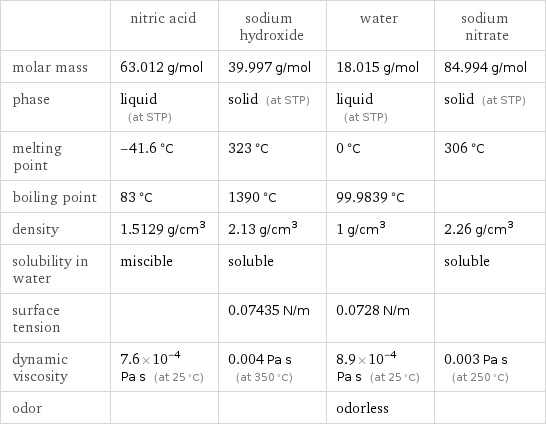
| nitric acid | sodium hydroxide | water | sodium nitrate molar mass | 63.012 g/mol | 39.997 g/mol | 18.015 g/mol | 84.994 g/mol phase | liquid (at STP) | solid (at STP) | liquid (at STP) | solid (at STP) melting point | -41.6 °C | 323 °C | 0 °C | 306 °C boiling point | 83 °C | 1390 °C | 99.9839 °C | density | 1.5129 g/cm^3 | 2.13 g/cm^3 | 1 g/cm^3 | 2.26 g/cm^3 solubility in water | miscible | soluble | | soluble surface tension | | 0.07435 N/m | 0.0728 N/m | dynamic viscosity | 7.6×10^-4 Pa s (at 25 °C) | 0.004 Pa s (at 350 °C) | 8.9×10^-4 Pa s (at 25 °C) | 0.003 Pa s (at 250 °C) odor | | | odorless |
Units
